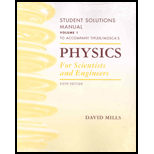
Concept explainers
(a)
The expression for
(a)
Answer to Problem 84P
The expression for
Explanation of Solution
Formula used:
The expression for the acceleration of the wood system is given by,
The expression for the distance of the system is given by,
Calculation:
The block is start from the rest position which means that the initial velocity of the block is,
The acceleration from
From equation (1) and equation (2), the expression of the gravity is written as,
Conclusion:
Therefore, the expression for
(b)
The proof that the small error in time measurement lead to the error in
(b)
Answer to Problem 84P
The value of
Explanation of Solution
Formula used:
The expression for
Calculation:
Differentiate the expression of
Solve further as,
Conclusion:
Therefore, the value of
(c)
The value of
(c)
Answer to Problem 84P
The value of
Explanation of Solution
Given:
The value of the
The value of the
The value of the
The value of the mass is,
Formula used:
The expression for
The expression for
Calculation:
The value of the time from the expression of
The value of the mass
Solve further as,
Conclusion:
Therefore, the value of
Want to see more full solutions like this?
Chapter 4 Solutions
Physics For Scientists And Engineers Student Solutions Manual, Vol. 1
- Compute the maximum velocity, maximum acceleration, and the maximum force.arrow_forwardCompute the weight of a 75 kg space ranger (a) on Earth, (b) on Mars, where g = 3.7 m/s2, and (c) in interplanetary space, where g = 0. (d) What is the ranger’s mass at each location?arrow_forwardCan a body have a constant speed but a varying velocity?arrow_forward
- Can A Body Have A Constant Speed And Still Have A Varying Velocity?arrow_forwardPaleontologists estimate that if a Tyrannosaurus rex had tripped and fallen, the ground would have exerted anormal force of approximately 260,000 N on its torso as it landed.Assuming the torso has a mass of 3800 kg, (a) find the magnitudeof the torso’s upward acceleration as it comes to rest. (For comparison, humans lose consciousness with an acceleration of about 7g.)(b) Assuming the torso of a T. rex is in free fall for a distance of 1.46m as it falls to the ground, how much time is required for the torsoto come to rest once it contacts the ground?arrow_forwardRecall that Newton’s Equation of Motion for a Body of Mass, m, is F = m(dv/dt). Assume the Initial Velocity of the Projectile is v0, and the Gravitational Acceleration Constant is g, where the Gravitational Force is Fg = -mg. Note that the Maximum Height will Occur at a Time, tm, when the Velocity Goes to Zero, v(tm) = 0. a) Simply Solve the Equation of Motion for the Velocity as a Function of Time, and Determine the Time it Takes the Projectile to Reach the Maximum Height, tm, As a Function of the Given Parameters. b) Include a Force of Air Resistance that is Proportional to the Velocity of the Form Fr = -kmv. Again, Solve the Equation of Motion for the Velocity as a Function of Time, by Direct Integration or by Choosing an Appropriate Ansatz Form for the Solution. Again, Determine an Expression for the Time it Takes the Projectile to Reach the Maximum Height, tm, As a Function of the Given Parameters. c) Finally, Compare the Two Results by First Checking that they Agree for a Small…arrow_forward
- THE MASSES Ma and Mb SLIDE ON THE SMOOTH INCLINED PLANES (WITHOUT FRICTION). DETERMINE A FORMULA FOR THE ACCELERATION OF THE SYSTEM IN TERMS OF mA,mB θA, θB AND g. B) IF θA= 32, θB=23 AND mA= 5.0kg, what value of MBwill keep the system at rest? What would be the tension in the string in this case (neglect mass)?arrow_forwardConsider an object of mass m being pushed up a frictionless incline of angle theta by a force F parallel to the ground (not the incline). If the object is moving at a constant velocity, the expression for F in terms of m, g (the acceleration due to gravity near the earth's surface, leave it as a letter), and theta is______ (The outcome that I found was F=MgTan(theta) The “not the incline” it confuses mearrow_forwardA dated box of dates, of mass 5.00 kg, is sent sliding up a frictionless ramp at an angle of to the horizontal as a function of time t, the component vx of the box’s velocity along an x axis that extends directly up the ramp.What is the magnitude of the normal force on the box from the ramp?arrow_forward
- A person with a mass of 80kg while dressed in a jump suit jumps from a plane while parachuting.They eventually reach a terminal speed of 60m/s. If you assume g = 10ms2 , = 1:21 kg m3 , what is the value of the product of constants cdA?arrow_forwardSketch an example pulley system where the speed of one mass is two times (2x) the speed of the second mass. For the system, determine the acceleration of one mass relative to the other mass.arrow_forwardIn a trial, a dog generated an instantaneous ground reaction force that was 1.7 times the dog’s weight and angled 14 degrees from vertical. What was the magnitude of the dog’s horizontal and vertical acceleration at that moment?arrow_forward
 University Physics Volume 1PhysicsISBN:9781938168277Author:William Moebs, Samuel J. Ling, Jeff SannyPublisher:OpenStax - Rice University
University Physics Volume 1PhysicsISBN:9781938168277Author:William Moebs, Samuel J. Ling, Jeff SannyPublisher:OpenStax - Rice University Classical Dynamics of Particles and SystemsPhysicsISBN:9780534408961Author:Stephen T. Thornton, Jerry B. MarionPublisher:Cengage Learning
Classical Dynamics of Particles and SystemsPhysicsISBN:9780534408961Author:Stephen T. Thornton, Jerry B. MarionPublisher:Cengage Learning Principles of Physics: A Calculus-Based TextPhysicsISBN:9781133104261Author:Raymond A. Serway, John W. JewettPublisher:Cengage Learning
Principles of Physics: A Calculus-Based TextPhysicsISBN:9781133104261Author:Raymond A. Serway, John W. JewettPublisher:Cengage Learning


